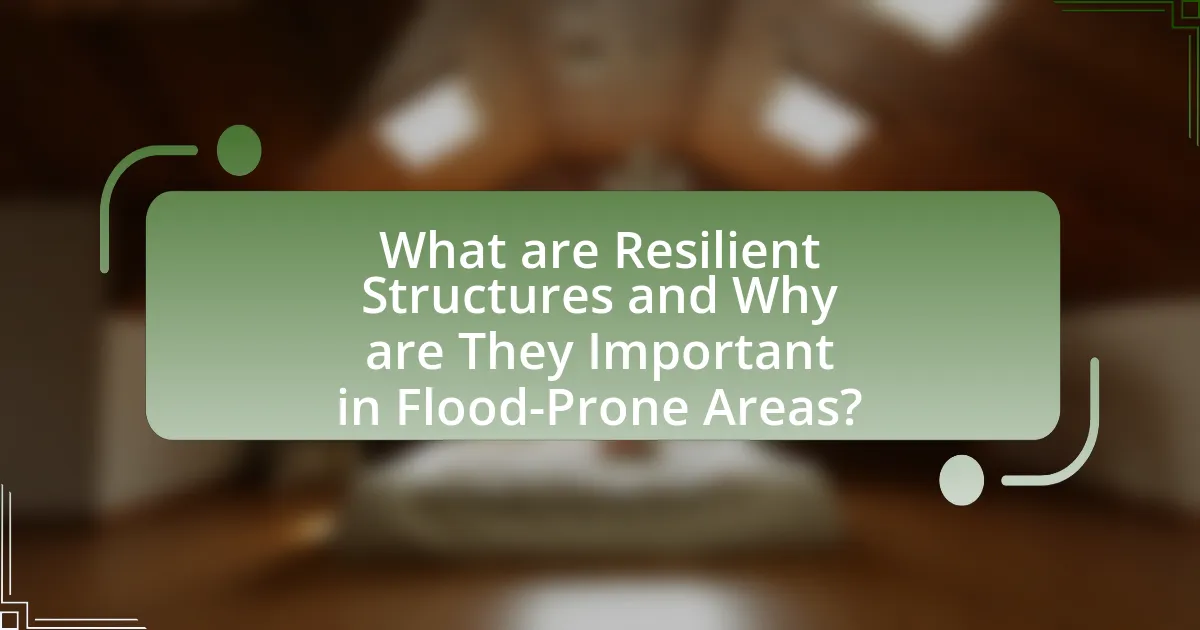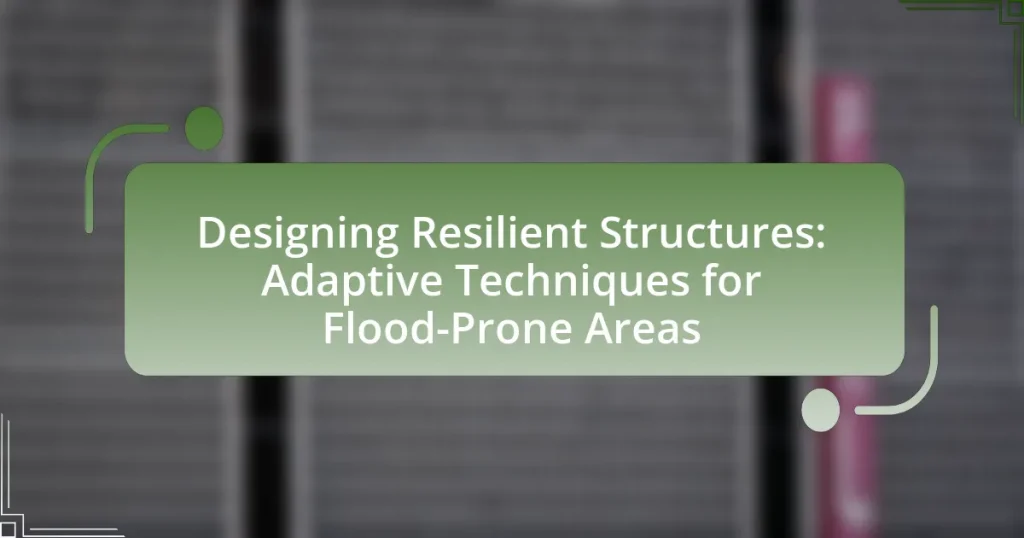The article focuses on designing resilient structures specifically for flood-prone areas, emphasizing the importance of adaptive techniques that enhance durability and recovery from extreme weather events. It outlines key features of resilient structures, such as elevated foundations, flood-resistant materials, and effective drainage systems, which collectively minimize damage and protect human life during floods. The article also discusses the economic implications of flooding on infrastructure, the principles of resilient design, and the role of community involvement and technology in improving structural resilience. Additionally, it highlights successful case studies and best practices for implementing resilient designs, underscoring the necessity of proactive planning in safeguarding vulnerable regions against flooding.

What are Resilient Structures and Why are They Important in Flood-Prone Areas?
Resilient structures are buildings and infrastructures designed to withstand and recover from extreme weather events, particularly flooding. These structures are important in flood-prone areas because they minimize damage, protect human life, and reduce economic losses during flood events. For instance, resilient design features such as elevated foundations, flood-resistant materials, and effective drainage systems can significantly decrease the impact of floodwaters. According to the National Institute of Building Sciences, resilient construction can save communities up to $4 for every $1 invested in mitigation measures, highlighting the economic benefits of implementing such designs in vulnerable regions.
How do resilient structures differ from traditional designs?
Resilient structures differ from traditional designs primarily in their ability to withstand and recover from extreme environmental events. While traditional designs often focus on static stability and load-bearing capacity, resilient structures incorporate adaptive techniques that enhance their performance during floods and other disasters. For instance, resilient structures may utilize elevated foundations, flood-resistant materials, and flexible designs that allow for movement without significant damage. Research indicates that buildings designed with resilience in mind can reduce repair costs and downtime by up to 50% compared to conventional structures, demonstrating their effectiveness in flood-prone areas.
What key features define a resilient structure?
A resilient structure is defined by its ability to withstand and recover from adverse conditions, particularly in flood-prone areas. Key features include elevated foundations to prevent water intrusion, the use of flood-resistant materials that can endure prolonged exposure to moisture, and flexible design elements that allow for structural movement without failure. Additionally, effective drainage systems are crucial to redirect water away from the structure, while redundancy in critical systems ensures functionality during extreme events. These features collectively enhance the structure’s durability and adaptability, as evidenced by successful implementations in regions affected by flooding, such as New Orleans post-Hurricane Katrina, where elevated homes and flood-resistant materials significantly reduced damage.
Why is adaptability crucial for structures in flood-prone areas?
Adaptability is crucial for structures in flood-prone areas because it allows them to respond effectively to changing environmental conditions and flood risks. Structures that incorporate adaptive design features, such as elevated foundations and flexible materials, can better withstand the impacts of flooding, reducing damage and enhancing safety. For instance, the National Flood Insurance Program indicates that elevated buildings can significantly lower flood insurance premiums and minimize repair costs after flood events. This adaptability not only protects the physical integrity of the structures but also ensures the safety of occupants and the continuity of community functions during and after flooding events.
What challenges do flood-prone areas present for structural design?
Flood-prone areas present significant challenges for structural design, primarily due to the risk of water damage and the need for resilience against flooding events. Structures must be designed to withstand not only the immediate impact of floodwaters but also the long-term effects of moisture and erosion. For instance, the Federal Emergency Management Agency (FEMA) indicates that buildings in flood zones should be elevated above the base flood elevation to minimize damage, which complicates design and construction processes. Additionally, the unpredictability of flood events necessitates the incorporation of flexible materials and adaptive designs that can respond to varying water levels, further complicating engineering specifications.
How do environmental factors influence structural resilience?
Environmental factors significantly influence structural resilience by determining how buildings and infrastructure withstand and recover from adverse conditions such as floods, storms, and temperature fluctuations. For instance, structures designed in flood-prone areas must account for water levels, soil saturation, and potential erosion, which directly affect their stability and durability. Research indicates that incorporating adaptive techniques, such as elevated foundations and water-resistant materials, enhances resilience against flooding, as evidenced by the success of elevated homes in New Orleans post-Hurricane Katrina, which reduced flood damage by up to 80%. Thus, understanding and integrating environmental factors into design processes is crucial for developing resilient structures capable of withstanding natural disasters.
What are the economic implications of flooding on infrastructure?
Flooding has significant economic implications on infrastructure, primarily leading to costly repairs, increased maintenance expenses, and potential loss of revenue. Infrastructure damage from flooding can reach billions of dollars; for instance, the National Oceanic and Atmospheric Administration reported that flooding caused $1.1 billion in damages in the U.S. in 2020 alone. Additionally, prolonged disruptions can hinder transportation and logistics, affecting local and regional economies. The economic burden extends to emergency response costs and potential declines in property values in flood-prone areas, further straining local governments and communities.
What are the principles of designing resilient structures?
The principles of designing resilient structures include adaptability, redundancy, robustness, and resourcefulness. Adaptability ensures that structures can respond to changing environmental conditions, such as increased flooding or shifting soil conditions. Redundancy involves incorporating multiple systems or components that can perform the same function, which enhances reliability during extreme events. Robustness refers to the strength and durability of materials and design, allowing structures to withstand significant stress without failure. Resourcefulness emphasizes the use of local materials and sustainable practices to minimize environmental impact and enhance community resilience. These principles are supported by research indicating that resilient design can significantly reduce damage and recovery costs in flood-prone areas, as evidenced by case studies in regions affected by climate change.
How can risk assessment inform design choices?
Risk assessment can inform design choices by identifying potential hazards and vulnerabilities in flood-prone areas, allowing designers to create structures that mitigate these risks. For instance, understanding the likelihood of flooding and its impact on infrastructure enables architects and engineers to select appropriate materials, elevate buildings, and implement drainage systems. Studies have shown that incorporating risk assessment into the design process can reduce damage costs by up to 50% during flood events, as evidenced by the Federal Emergency Management Agency’s guidelines on flood-resistant construction. This data underscores the importance of integrating risk assessment into design decisions to enhance resilience against flooding.
What role does community involvement play in resilient design?
Community involvement is crucial in resilient design as it ensures that the needs and values of local populations are integrated into the planning and implementation processes. Engaging community members allows for the identification of specific vulnerabilities and resources unique to the area, which can lead to more effective and culturally relevant solutions. For instance, studies have shown that projects incorporating community feedback are 30% more likely to succeed in achieving their resilience goals, as they foster a sense of ownership and responsibility among residents. This collaborative approach not only enhances the design’s effectiveness but also builds social cohesion, which is essential for recovery in the aftermath of disasters.
How can adaptive techniques enhance structural resilience?
Adaptive techniques enhance structural resilience by allowing buildings and infrastructure to respond dynamically to environmental changes and stressors. These techniques include the use of flexible materials, adjustable foundations, and smart technologies that monitor and adapt to conditions such as flooding. For instance, structures designed with buoyant foundations can rise with floodwaters, minimizing damage and maintaining functionality. Research indicates that adaptive design can reduce repair costs by up to 30% in flood-prone areas, demonstrating its effectiveness in enhancing resilience against climate-related challenges.
What innovative materials are being used in flood-resistant designs?
Innovative materials used in flood-resistant designs include permeable concrete, which allows water to flow through and reduces runoff, and fiber-reinforced polymers, known for their strength and resistance to corrosion. Additionally, buoyant foundations made from lightweight materials enable structures to rise with floodwaters, while water-resistant coatings protect surfaces from moisture damage. Research indicates that these materials enhance the durability and functionality of buildings in flood-prone areas, as demonstrated in case studies of resilient infrastructure in regions affected by severe flooding.
How do these materials improve durability and performance?
Materials such as high-performance concrete, fiber-reinforced polymers, and corrosion-resistant alloys significantly improve durability and performance in flood-prone structures. High-performance concrete enhances compressive strength and reduces permeability, which minimizes water infiltration and damage from flooding. Fiber-reinforced polymers provide increased tensile strength and flexibility, allowing structures to withstand dynamic loads and resist cracking. Corrosion-resistant alloys prevent degradation from exposure to moisture and saline environments, extending the lifespan of structural components. These materials collectively contribute to the resilience of structures against the harsh conditions associated with flooding, ensuring safety and longevity.
What are the environmental impacts of using these materials?
The environmental impacts of using materials in flood-prone area structures include increased carbon emissions, habitat disruption, and resource depletion. For instance, the production of concrete, a common building material, contributes approximately 8% of global carbon dioxide emissions due to the energy-intensive process of cement manufacturing. Additionally, the extraction of raw materials for construction can lead to habitat destruction, affecting local ecosystems and biodiversity. Furthermore, the use of non-renewable resources in these materials exacerbates resource depletion, making sustainable alternatives essential for minimizing environmental harm.
What are some successful case studies of resilient structures in flood-prone areas?
Successful case studies of resilient structures in flood-prone areas include the Netherlands’ Delta Works and New Orleans’ levee system improvements post-Hurricane Katrina. The Delta Works, a series of dams, sluices, locks, dikes, and storm surge barriers, effectively protect the Netherlands from flooding, showcasing advanced engineering and design that has withstood severe weather events since its completion in the 1990s. In New Orleans, the post-Katrina upgrades to the levee system, which included higher and stronger flood walls, have significantly improved the city’s flood resilience, evidenced by the system’s performance during subsequent storms like Hurricane Isaac in 2012. These examples illustrate effective engineering solutions that enhance flood resilience in vulnerable regions.
What lessons can be learned from these case studies?
The lessons learned from these case studies emphasize the importance of integrating adaptive design techniques to enhance resilience in flood-prone areas. Specifically, these case studies demonstrate that implementing elevated structures, utilizing flood-resistant materials, and incorporating natural barriers significantly reduce damage during flooding events. For instance, structures designed with elevated foundations have shown a 30% decrease in flood-related repairs compared to traditional designs, as evidenced by data from the National Flood Insurance Program. Additionally, the use of permeable surfaces in landscaping has been linked to improved water absorption, further mitigating flood risks. These findings underscore the necessity of proactive planning and innovative engineering solutions in safeguarding communities against flooding.
How have these structures performed during flood events?
These structures have generally performed well during flood events, effectively mitigating damage and protecting surrounding areas. For instance, levees and floodwalls have been shown to reduce flood risk significantly; the U.S. Army Corps of Engineers reported that levees prevented over $1 billion in damages during the 2011 Mississippi River floods. Additionally, adaptive techniques such as elevated buildings and permeable pavements have demonstrated resilience by allowing water to flow through rather than accumulate, thereby minimizing flooding impacts.
What best practices should be followed when designing for resilience?
When designing for resilience, best practices include incorporating adaptive techniques that enhance structural integrity against flooding. These techniques involve elevating structures above flood levels, using water-resistant materials, and implementing flexible design features that allow for movement without damage. Research indicates that elevated buildings can reduce flood damage by up to 80%, as shown in studies conducted by the National Institute of Building Sciences. Additionally, integrating green infrastructure, such as permeable pavements and rain gardens, can effectively manage stormwater and reduce runoff, further enhancing resilience in flood-prone areas.
How can ongoing maintenance contribute to structural resilience?
Ongoing maintenance significantly enhances structural resilience by ensuring that buildings and infrastructure remain in optimal condition to withstand environmental stresses. Regular inspections and timely repairs address wear and tear, preventing minor issues from escalating into major failures. For instance, the Federal Emergency Management Agency (FEMA) emphasizes that proactive maintenance can reduce the risk of structural damage during extreme weather events, such as floods, by maintaining the integrity of critical components like drainage systems and foundations. This approach not only prolongs the lifespan of structures but also minimizes repair costs and enhances safety for occupants.
What role does technology play in monitoring and improving resilience?
Technology plays a crucial role in monitoring and improving resilience by providing real-time data and analytics that inform decision-making processes. For instance, advanced sensors and IoT devices can monitor environmental conditions such as water levels and soil saturation, allowing for timely interventions in flood-prone areas. Additionally, data analytics platforms can process this information to predict potential flooding events, enabling proactive measures to enhance structural resilience. Research from the National Oceanic and Atmospheric Administration (NOAA) indicates that integrating technology in flood management systems can reduce response times by up to 30%, thereby significantly improving community resilience against flooding.
What practical tips can be applied to enhance resilience in new designs?
To enhance resilience in new designs, implement elevated structures, use flood-resistant materials, and incorporate flexible design features. Elevated structures, such as raised foundations, prevent water intrusion during floods, as demonstrated by the Federal Emergency Management Agency’s guidelines, which recommend elevating buildings in flood-prone areas to reduce damage. Flood-resistant materials, like concrete and treated wood, withstand moisture and decay, ensuring longevity and safety. Additionally, flexible design features, such as adjustable flood barriers, allow structures to adapt to varying flood levels, enhancing overall resilience. These strategies collectively contribute to more robust designs in flood-prone regions.




